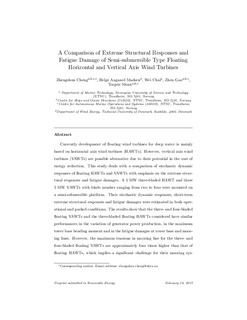| dc.contributor.author | Cheng, Zhengshun | |
| dc.contributor.author | Madsen, Helge Aagard | |
| dc.contributor.author | Chai, Wei | |
| dc.contributor.author | Gao, Zhen | |
| dc.contributor.author | Moan, Torgeir | |
| dc.date.accessioned | 2017-10-16T08:51:48Z | |
| dc.date.available | 2017-10-16T08:51:48Z | |
| dc.date.created | 2017-03-31T16:11:00Z | |
| dc.date.issued | 2017 | |
| dc.identifier.citation | Renewable Energy. 2017, 108 207-219. | nb_NO |
| dc.identifier.issn | 0960-1481 | |
| dc.identifier.uri | http://hdl.handle.net/11250/2460234 | |
| dc.description.abstract | Currently development of floating wind turbines for deep water is mainly based on horizontal axis wind turbines (HAWTs). However, floating vertical axis wind turbines (VAWTs) are possible alternative due to their potential in the cost of energy reduction. This study deals with a comparison of stochastic dynamic responses of floating HAWTs and VAWTs with emphasis on the extreme structural responses and fatigue damages. A 5 MW three-bladed HAWT and three 5 MW VAWTs with blade number ranging from two to four were mounted on a semi-submersible platform. Their stochastic dynamic responses, short-term extreme structural responses and fatigue damages were estimated in both operational and parked conditions. The results show that the three- and four-bladed floating VAWTs and the three-bladed floating HAWTs considered have similar performances in the variation of generator power production, in the maximum tower base bending moment and in the fatigue damages at tower base and mooring lines. However, the maximum tensions in mooring line for the three- and four-bladed floating VAWTs are approximately four times higher than that of floating HAWTs, which implies a significant challenge for their mooring systems. The maximum tower base bending moment and fatigue damage in the two-bladed floating VAWT are extremely significant. | nb_NO |
| dc.language.iso | eng | nb_NO |
| dc.publisher | Elsevier | nb_NO |
| dc.relation.uri | http://dx.doi.org/10.1016/j.renene.2017.02.067 | |
| dc.rights | Attribution-NonCommercial-NoDerivatives 4.0 Internasjonal | * |
| dc.rights.uri | http://creativecommons.org/licenses/by-nc-nd/4.0/deed.no | * |
| dc.title | A comparison of extreme structural responses and fatigue damage of semi-submersible type floating horizontal and vertical axis wind turbines | nb_NO |
| dc.type | Journal article | nb_NO |
| dc.type | Peer reviewed | nb_NO |
| dc.description.version | acceptedVersion | nb_NO |
| dc.source.pagenumber | 207-219 | nb_NO |
| dc.source.volume | 108 | nb_NO |
| dc.source.journal | Renewable Energy | nb_NO |
| dc.identifier.doi | 10.1016/j.renene.2017.02.067 | |
| dc.identifier.cristin | 1462869 | |
| dc.description.localcode | © 2017. This is the authors’ accepted and refereed manuscript to the article. LOCKED until 24.2.2019 due to copyright restrictions. This manuscript version is made available under the CC-BY-NC-ND 4.0 license http://creativecommons.org/licenses/by-nc-nd/4.0/ | nb_NO |
| cristin.unitcode | 194,64,20,0 | |
| cristin.unitname | Institutt for marin teknikk | |
| cristin.ispublished | true | |
| cristin.fulltext | postprint | |
| cristin.qualitycode | 1 | |

